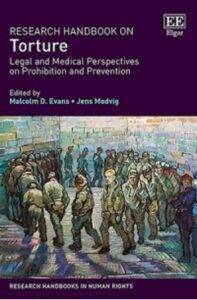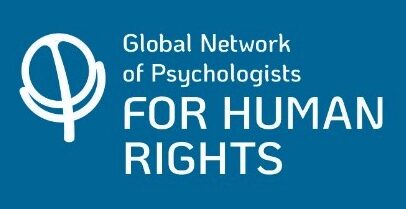 A brief presentation by Nora Sveaass, on the recently published Research Handbook on Torture: Legal and Medical Perspectives on Prohibition and Prevention, Ed.by Sir Malcolm D. Evans, and Jens Modvig. December 2020 ISBN: 978 1 78811 395 3
A brief presentation by Nora Sveaass, on the recently published Research Handbook on Torture: Legal and Medical Perspectives on Prohibition and Prevention, Ed.by Sir Malcolm D. Evans, and Jens Modvig. December 2020 ISBN: 978 1 78811 395 3
Introduction
When the two chairs of the main anti-torture bodies in the UN system, namely the Committee Against Torture (Modvig) and the Subcomittee on the Prevention of Torture (Evans) put their efforts together to develop a book on Torture – research, prevention and prohibition, you can be sure that what they had in mind – and now have succeeded in doing – is putting together texts that are relevant, important, updated and will contribute to the overarching fight against torture.
As said in the presentation of the book “this Research Handbook is of great importance in an era where torture, whilst universally condemned, remains endemic. It explores the nature of the international prohibition of torture and the various means and mechanisms which have been put in place by the international community in an attempt to make that prohibition a reality”.
Outline of the book
Torture is a sinister form of violation with many dimensions – hence, writing about this entails drawing on a many different perspectives. In their introduction, Jens Modvig and Sir Malcolm Evans give a thorough outline of the book, its objectives, structure and a good overview of the different chapters. The editors themselves inform us that despite the range of different ways in which this subject can be discussed, the present book focuses on the legal and medical dimensions of the prohibition. We hear from a number of different experts , all with experiences related to work against torture, be it in clinical care, as UN experts, from engagement in international criminal settings as well as domestic legal contexts, or as academicians studying these phenomena with a view to contribute to its eradication.
Together, the authors draw a nuanced and at the same time, a broad picture of the crime of torture, how it is practiced in the world, what effects it has in the lives of those subjected to this violation and the different ways in which torture can be prevented. Furthermore, it describes international procedures for investigation and securing accountability, and presents the readers with the impressive work behind international and regional conventions, treaties and resolutions aiming at not only prohibiting torture, but ensuring that the prohibition is respected, and that violations against this, are duly reacted to and if possible, punished.
Despite the fact that the existing treaties only bind the states that have ratified them, the prohibition of torture is today recognized as being a norm of “jus cogens”, which means that the prohibition is valid and overrides other legal obligations in the states (p. 1). Even with this in mind, it is important that the actual ratification of the most prominent and central anti-torture mechanism, namely the UN Convention Against Torture (CAT), is today ratified by 170 states of the world, and there is a steady and ongoing work to obtain universal ratification of the Convention. States that are State Parties to the Torture Convention, have accepted regular insight into and monitoring of their compliance with the provisions of the Convention, including among others, the total prohibition, prevention, accountability, protection, and redress for victims of torture. The Committee Against Torture, mandated to review the states on a regular basis, have also developed general comments and recommendations to the states in relation to these most central provisions, also described in the book. A very good overview of the actual work of the Committee Against Torture, what this entails, and how it has developed over the years, is written by Felice Gaer, a member for almost 20 years.
The Research Handbook on Torture, first time published in December 2020, contains an in-depth presentation and analysis of international and regional treaties and how these are of the essence in the global efforts against torture, including very relevant chapters on prevention of torture (Malcolm Evans; Richard Carver and Lisa Handley; Barbara Bernath), universal jurisdiction (Lutz Oette), on the regional human rights systems (Christine Bicknell; Diego Rodriguez-Pinzon; Lawrence Murugu Mute) and on the role of the special Rapporteur on Torture (Juan Mendez and Andra Nicolescu).
The book also includes chapters digging deeply into specifically challenging issues, often raised in the wake of discussions on torture. First of all, there is the chapter by Michelle Farrell, exploring the arguments that have been heard far too often over the last two decades, that torture may be instrumental in obtaining information that may save lives of others. That is, using torture as part of interrogation, such as in cases with persons suspected of crimes related to terrorism. Raising the “ticking bomb” scenario, the chapter gives an important overview over this debate, emphasizing the principle of the absolute prohibition and no justification of torture whatsoever. Another relevant topic in relation to torture is discussed in the chapter on using information obtained through torture or other forms of ill-treatment, written by Matt Pollard. The chapter highlights the importance of article 15 in the UN Conventions prohibiting use of information obtained through torture, in court, except when the torture itself is the issue. Through important historical examples and jurisprudence, we are given very good insight into this question.
There is no way that any short comment on this book – with 27 chapters and almost 600 pages – can do justice to the richness and complexity of the book. But to follow up on what I have referred to as chapters digging into issues not always given centre stage, I would like to comment the chapter by Carla Ferstman where she writes about torture and non-refoulement and highlights the differences between refugee and human rights law, giving a number of updated examples and references, including court decisions and public debates. In particular, she reminds us of serious attempts to undermine the right to seek protection, such as pushbacks at sea. The chapters about foreign state immunities as a barrier to access remedies, by Lorna McGregor, also reminds us of the many levels on which problems can be encountered in the international struggle against torture but also against impunity for the crime of torture.
In addition, the book contains chapters on torture and international medical ethics standard (Vivienne Nathanson), on medico-legal documentation of torture and ill treatment, in particular the Istanbul protocol (Vince Iacopini) and on the consequences of torture on health (Jose Quiroga and Jens Modvig). The question related to psychological torture is raised, and in the chapter by Pau Perez-Sales he describes both what this means, how it is practiced and what effects it may have. His appeal to all, to make sure that this form of torture does not fall under the radar, often for the lack of physical and tangible marks, is a very important one. The importance of rehabilitation, in particular as laid down in article 14 of the CAT is described in the chapter by Nora Sveaass, Felice Gaer and Claudio Grossman, and Nimisha Patel highlights the need of going beyond individual therapeutic approaches in psychological care with survivors of torture.
To put it in the shortest possible way: As a psychologist myself, for many years involved in clinical work with survivors of torture, and also, having been able to participate in the international work against torture, as member to the two UN anti-torture bodies, and also active in civil society organisations working for human rights, I recommend this book to all those interested in this extremely painful and thereby, extremely important subject. It provides health professionals with the insight we need to understand the legal framework and context, and it offers a great insight into health consequences, and in particular mental health and social consequences of torture, to those mostly engaged in legal issues related to this.

